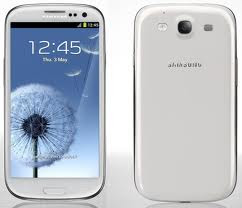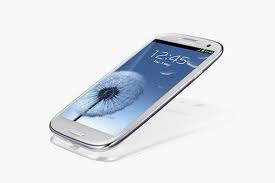 The Galaxy S III is a departure from the styling seen with the Galaxy S II. Now, the phone has rounded corners that give it a somewhat friendlier look. Gone is the simplistic rectangular silhouette of the S II, making way for a new, pebble-inspired shape. Overall, Samsung has claimed to have been very inspired by Nature when it comes to the Galaxy S III, trying to make the phone as people-friendly as possible.
The Galaxy S III is a departure from the styling seen with the Galaxy S II. Now, the phone has rounded corners that give it a somewhat friendlier look. Gone is the simplistic rectangular silhouette of the S II, making way for a new, pebble-inspired shape. Overall, Samsung has claimed to have been very inspired by Nature when it comes to the Galaxy S III, trying to make the phone as people-friendly as possible.Meanwhile, due to a radical increase in screen size, the phone's overall dimensions are much bigger compared to its predecessor. The Samsung Galaxy S III is definitely on the bulkier side, which makes it extremely difficult to operate if you have to use just one hand. The home key, which is positioned near the bottom edge of the phone, is often hard to reach because of the handset's size. Anyway, the Galaxy S III isn't significantly bigger than the rest of the top models in its class, so having such big dimensions is now pretty much standard. Samsung has tried to decrease the size of the bezel so that the bigger screen doesn't impact the overall device dimensions dramatically, but even with those efforts, the S III is as big as the Nexus, which is already quite big.
With that out of the way, the device by no means looks bad. Its inspired by nature design is actually quite relaxing and feels good in the hand. Due to the phone's thinness (8.6mm) and light weight, the Galaxy S III doesn't feel too much like the bulky phone that it is.
 As we said in our introduction, many fans hoped to see a new fancy ceramic coating used for the S III, which would have given the handset a new, premium appearance. Unfortunately, that didn't happen, and we were treated to the good-old plastic solution. Well, technically, the material used for the handset is polycarbonate, but it definitely doesn't feel as high-quality and premium as the body of the One X, for example. This has practically guaranteed a relatively light (good), but also uninspiring (bad) construction. Samsung has come up with the name “Hyperglaze” for the specific finish of the utilized plastic, but we couldn't find anything that special in it. It's just a glossy plastic with an OK texture on it.
As we said in our introduction, many fans hoped to see a new fancy ceramic coating used for the S III, which would have given the handset a new, premium appearance. Unfortunately, that didn't happen, and we were treated to the good-old plastic solution. Well, technically, the material used for the handset is polycarbonate, but it definitely doesn't feel as high-quality and premium as the body of the One X, for example. This has practically guaranteed a relatively light (good), but also uninspiring (bad) construction. Samsung has come up with the name “Hyperglaze” for the specific finish of the utilized plastic, but we couldn't find anything that special in it. It's just a glossy plastic with an OK texture on it.There are just three physical buttons on the Galaxy S III(actually four, if you count the volume rocker as two buttons). The home key, situated under the display, is surrounded by old-school capacitive menu and back keys. Apparently, Samsung isn't willing to make the switch to on-screen navigational keys for its flagship line just yet. We aren't big fans of the exact position chosen for the home button and even the capacitive keys surrounding it. They don't take the center of the plastic area below the screen (considering the vertical axis); instead, they are placed a bit lower. While this may sound as nitpicking to you, it does have a significant (negative) effect on the appearance and comfort of using the phone. It has a negative effect on the appearance, because the home key look very good in this position, while the comfort is compromised because the capacitive keys sit too close to the edge, meaning they are easy to press accidentally (yep, we had many of those frustrating moments).
The home key and volume rocker respond well when pressed, but the power/lock key isn't very well made. We noticed that it's not particularly clicky and you can hardly tell if you've manged to press it just by feel.
 Of course, there's the usual 3.5mm jack at the top, as well as microUSB at the bottom. The glossy back houses an 8MP camera with LED flash and the speaker grill right beside it. Interestingly, gone is the characteristic bump that's present on the lower-back sides of the Galaxy S and S II. Not that we'll be missing it much. Removing the flimsy back cover will grant you access to the Micro-SIM and microSD card slots.
Of course, there's the usual 3.5mm jack at the top, as well as microUSB at the bottom. The glossy back houses an 8MP camera with LED flash and the speaker grill right beside it. Interestingly, gone is the characteristic bump that's present on the lower-back sides of the Galaxy S and S II. Not that we'll be missing it much. Removing the flimsy back cover will grant you access to the Micro-SIM and microSD card slots.On the exterior, the Galaxy S III looks similarly to the Galaxy Nexus and carries a dimension of 136.6 x 70.6 x 8.6 mm and a weight of 133g. It is a tad thicker and heavier than its predecessor, the Galaxy S II. It will be available in two colours at launch, Pebble Blue and Marble White.
Dominating the phone’s surface is the 4.8-inch HD Super AMOLED display that supports 1280 x 720 resolution pixels. Samsung cleverly avoided mentioning the processor of the device, but various report pointed that it is powered by the latest 1.4GHz Exynos 4 Quad processor together with 1GB of RAM.
Source From - Samsung Galaxy S III Review &
Samsung Galaxy S III Preview
1 comments:
http://ww.rpinternational.org/home/tramadolonline/#7 buy tramadol online no prescription - buy tramadol online for saturday delivery